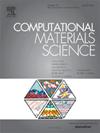体晶界扩散的三维模拟:在(U, Pu)O2体系中的应用
IF 3.3
3区 材料科学
Q2 MATERIALS SCIENCE, MULTIDISCIPLINARY
引用次数: 0
摘要
在微观尺度上,阳离子的扩散对氧化物微观结构的演变起着至关重要的作用,直接影响材料在使用过程中的性能。在混合氧化物(U, Pu)O2的情况下,在球团烧结过程中,钚、铀和氧离子的扩散负责它们在燃料中的最终分布,有助于其均质化。这一过程受烧结炉的热力学条件控制,它通过两种主要的传递机制影响扩散速率:晶界扩散和体扩散。建立了一个数值模型来模拟烧结过程中燃料内部的扩散,以便更好地了解扩散对燃料均匀化的影响。该模型旨在模拟阳离子向体内扩散这一最慢的过程,加上阳离子在晶界处的快速扩散,同时考虑到氧化物离子比金属阳离子的快速扩散。对模型的数值计算结果进行了比较,结果与采用扩散偶法得到的实验数据吻合较好。此外,该模型使处理更复杂的实验构型(球面扩散对之间的界面)成为可能。它也可以用来模拟混合氧化物(U, Pu)O2热处理过程中Pu浓度的变化。该模型可作为未来制造路线或新型燃料微结构设计的工具。本文章由计算机程序翻译,如有差异,请以英文原文为准。

Three-dimensional modeling of diffusion in bulk and grain boundaries: application to (U, Pu)O2 system
The diffusion of cations on a microscopic scale plays a crucial role in the evolution of the microstructure of oxides, which has a direct impact on the performance of the material during its use. In the case of the mixed oxide (U, Pu)O2, the diffusion of plutonium, uranium and oxygen ions during pellet sintering is responsible for their final distribution in the fuel, contributing to its homogenization. This process is governed by the thermodynamic conditions of the sintering furnace, which influence the rate of diffusion via two main transport mechanisms: grain boundary diffusion and bulk diffusion.
A numerical model has been developed to simulate diffusion within the fuel during sintering and to better understand the impact of diffusion on fuel homogenization. This model is designed to simulate the diffusion of cations into the bulk, the slowest process, coupled with the faster diffusion of cations at grain boundaries, while taking into account the faster diffusion of oxide ions compared with metal cations.
Numerical results from the model have been compared and are in good agreement with experimental data obtained using the diffusion couple method. In addition, the model makes it possible to handle more complex experimental configurations (interface between spherical diffusion pairs). It can also be used to simulate the evolution of Pu concentration during heat treatment of a mixed oxide (U, Pu)O2. This model could be used as a tool for the design of future fabrication routes or new fuel microstructures.
求助全文
通过发布文献求助,成功后即可免费获取论文全文。
去求助
来源期刊

Computational Materials Science
工程技术-材料科学:综合
CiteScore
6.50
自引率
6.10%
发文量
665
审稿时长
26 days
期刊介绍:
The goal of Computational Materials Science is to report on results that provide new or unique insights into, or significantly expand our understanding of, the properties of materials or phenomena associated with their design, synthesis, processing, characterization, and utilization. To be relevant to the journal, the results should be applied or applicable to specific material systems that are discussed within the submission.
 求助内容:
求助内容: 应助结果提醒方式:
应助结果提醒方式:


